| |||||
| Decades: | |||||
|---|---|---|---|---|---|
| See also: | |||||
| 1845 in the United States |
| 1845 in U.S. states |
|---|
| States |
| Washington, D.C. |
| List of years in the United States by state or territory |
Events from the year 1845 in the United States.
| |||||
| Decades: | |||||
|---|---|---|---|---|---|
| See also: | |||||
| 1845 in the United States |
| 1845 in U.S. states |
|---|
| States |
| Washington, D.C. |
| List of years in the United States by state or territory |
Events from the year 1845 in the United States.
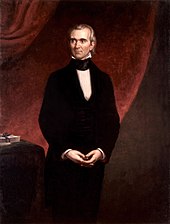
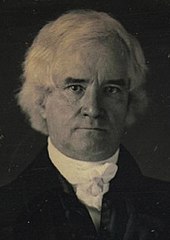
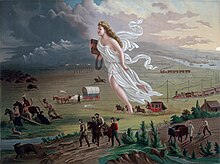
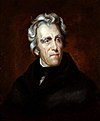
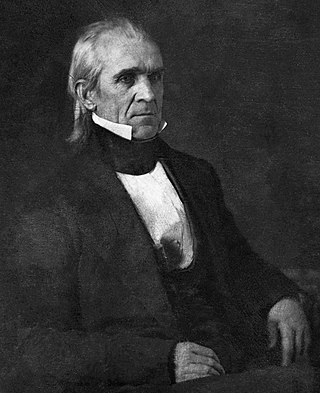
James Knox Polk was the 11th president of the United States, serving from 1845 to 1849. He also served as the 13th speaker of the House of Representatives from 1835 to 1839 and the ninth governor of Tennessee from 1839 to 1841. A protégé of Andrew Jackson, he was a member of the Democratic Party and an advocate of Jacksonian democracy. Polk is known for extending the territory of the United States through the Mexican–American War during his presidency, annexing the Republic of Texas, the Oregon Territory, and the Mexican Cession after winning the Mexican–American War.
1845 (MDCCCXLV) was a common year starting on Wednesday of the Gregorian calendar and a common year starting on Monday of the Julian calendar, the 1845th year of the Common Era (CE) and Anno Domini (AD) designations, the 845th year of the 2nd millennium, the 45th year of the 19th century, and the 6th year of the 1840s decade. As of the start of 1845, the Gregorian calendar was 12 days ahead of the Julian calendar, which remained in localized use until 1923.
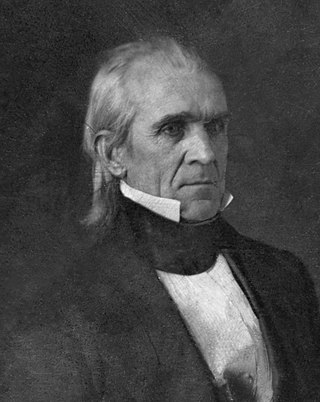
The 1844 United States presidential election was the 15th quadrennial presidential election, held from Friday, November 1 to Wednesday, December 4, 1844. Democrat James K. Polk narrowly defeated Whig Henry Clay in a close contest turning on the controversial issues of slavery and the annexation of the Republic of Texas. This is the only election in which both major party nominees served as Speaker of the House at one point, and the first in which neither candidate held elective office at the time.
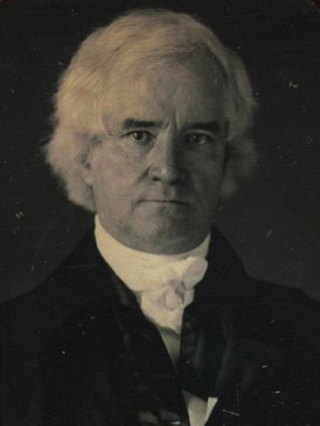
George Mifflin Dallas was an American politician and diplomat who served as mayor of Philadelphia from 1828 to 1829, the 11th vice president of the United States from 1845 to 1849, and U.S. Minister to the United Kingdom from 1856 to 1861.
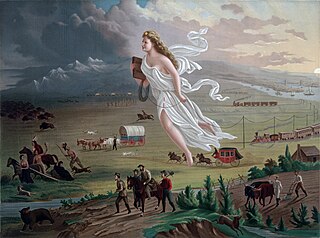
Manifest destiny was a phrase that represented the belief in the 19th-century United States that American settlers were destined to expand westward across North America, and that this belief was both obvious ("manifest") and certain ("destiny"). The belief was rooted in American exceptionalism and Romantic nationalism, implying the inevitable spread of the Republican form of governance. It was one of the earliest expressions of American imperialism in the United States of America.

The Treaty of Guadalupe Hidalgo officially ended the Mexican–American War (1846–1848). It was signed on 2 February 1848 in the town of Guadalupe Hidalgo.

The Republic of Texas was annexed into the United States and admitted to the Union as the 28th state on December 29, 1845.

John Louis O'Sullivan was an American columnist, editor, and diplomat who coined the term "manifest destiny" in 1845 to promote the annexation of Texas and the Oregon Country to the United States. O'Sullivan was an influential political writer and advocate for the Democratic Party at that time and served as U.S. minister to Portugal during the administration of President Franklin Pierce (1853–1857).
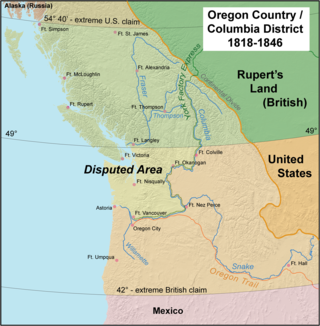
The Oregon boundary dispute or the Oregon Question was a 19th-century territorial dispute over the political division of the Pacific Northwest of North America between several nations that had competing territorial and commercial aspirations in the region.

Robert James Walker was an American lawyer, economist and politician. An active member of the Democratic Party, he served as a member of the U.S. Senate from Mississippi from 1835 until 1845, as Secretary of the Treasury from 1845 to 1849 during the administration of President James K. Polk, and briefly as Territorial Governor of Kansas in 1857. He was responsible for drafting the 1849 bill that eventually established the United States Department of the Interior.
The All of Mexico Movement, or All Mexico Movement, was a political movement to expand the United States to incorporate all of Mexico. It was a controversial aspect of Manifest Destiny that was unable to garner enough political support to encourage adoption. The Mexican-American War (1846–1848) brought the United States and Mexico into conflict over various geopolitical issues, including a desire to invade and annex much of Mexico, that resulted in victory for the United States.
Jane Maria Eliza Cazneau was an Irish-American journalist, lobbyist, and publicist who advocated the annexation of all of Mexico during the Mexican–American War.
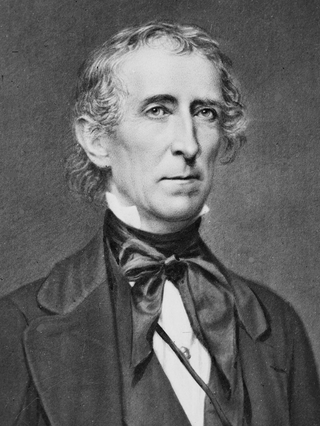
The presidency of John Tyler began on April 4, 1841, when John Tyler became President of the United States upon the death of President William Henry Harrison, and ended on March 4, 1845. He had been Vice President of the United States for only 31 days when he assumed the presidency. The tenth United States president, he was the first to succeed to the office intra-term without being elected to it. To forestall constitutional uncertainty, Tyler took the presidential oath of office on April 6, assumed full presidential powers, and served out the balance of Harrison's four-year term, a precedent that would govern future extraordinary successions and eventually become codified in the Twenty-fifth Amendment.

The presidency of James K. Polk began on March 4, 1845, when James K. Polk was inaugurated as President of the United States, and ended on March 4, 1849. He was a Democrat, and assumed office after defeating Whig Henry Clay in the 1844 presidential election. Polk left office after one term, fulfilling a campaign pledge he made in 1844, and he was succeeded by Whig Zachary Taylor. A close ally of Andrew Jackson, Polk's presidency reflected his adherence to the ideals of Jacksonian democracy and manifest destiny.

The 1844 Democratic National Convention was a presidential nominating convention held in Baltimore, Maryland from May 27 through 30. The convention nominated former Governor James K. Polk of Tennessee for president and former Senator George M. Dallas of Pennsylvania for vice president.

Events from the year 1846 in the United States. In this year, the United States declares war on Mexico, starting the Mexican–American War.
Events from the year 1849 in the United States.
Richard Franklin Bache, also known as Richard Bache Jr. (1784–1848), was a military and political official in the Republic and state of Texas. He assisted in drafting the Texas Constitution of 1845, the first of its five state constitutions.

Republic of Texas–United States relations refers to the historical foreign relations between the now-defunct Republic of Texas and the United States of America. Relations started in 1836 after the Texas Revolution and ended in 1845 upon the annexation of Texas by the United States.

The history of U.S. foreign policy from 1829 to 1861 concerns the foreign policy of the United States during the presidential administrations of Andrew Jackson, Martin Van Buren, William Henry Harrison, John Tyler, James K. Polk, Zachary Taylor, Millard Fillmore, Franklin Pierce, and James Buchanan. During this era, the United States annexed the Republic of Texas, acquired the Mexican Cession by defeating Mexico in the Mexican–American War and partitioned Oregon Country with the United Kingdom of Great Britain and Ireland. The period began with the inauguration of Jackson in 1829, while the onset of the American Civil War in 1861 marked the start of the next period in U.S. foreign policy.